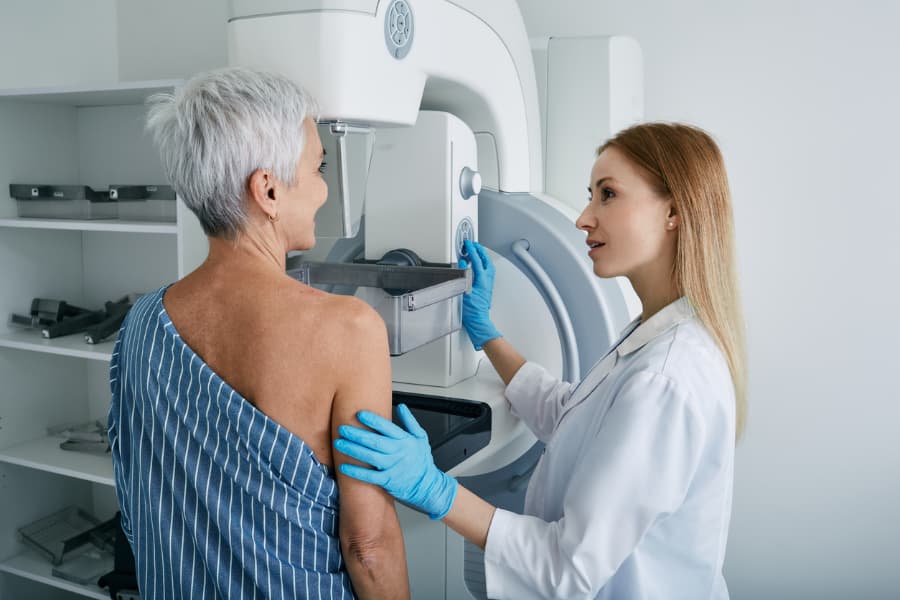Breast cancer remains a leading cause of morbidity and mortality worldwide. In the U.S., one in eight women is expected to develop breast cancer in their lifetime. Laboratory testing is indispensable in the diagnosis and management of this disease. In recognition of National Breast Cancer Awareness Month, observed each October, this blog highlights the key laboratory tests central to breast cancer care and how they influence treatment decisions.
Histologic Evaluation: The First Step in Breast Cancer Care
Early detection significantly improves patient outcomes and laboratory testing is vital to this process. When an abnormality is found during a physical exam or mammogram, tissue samples are collected for evaluation. Pathologists meticulously analyze these samples microscopically to assess the presence of cancer cells and determine whether a tumor is invasive or in-situ (confined). They also evaluate histologic subtypes, tumor grades and other key histologic parameters. This comprehensive analysis, along with radiologic findings, helps guide clinicians in determining the most appropriate treatment, whether surgery, chemotherapy, radiation or a combination of these modalities.
Predictive Marker Testing: Personalizing Treatment
Predictive marker testing is integral to personalized breast cancer therapy, enabling therapies to be tailored to the tumor’s molecular profile. Key markers include the estrogen receptor (ER), progesterone receptor (PR) and HER2/neu.
The detection of ER and PR by immunohistochemistry (IHC) signifies that the tumor is hormone-driven. This supports the use of hormone-blocking therapies, such as tamoxifen or aromatase inhibitors, as effective treatment for patients with ER-positive breast cancers.
HER2/neu, a growth factor receptor, drives aggressive tumor growth when overexpressed. About 15-20% of breast cancers are HER2/neu-positive and often respond well to trastuzumab (Herceptin), which blocks HER2/neu function. HER2/neu status is typically assessed through IHC to detect protein overexpression or in-situ hybridization (ISH) to identify gene amplification.
Triple-negative breast cancer (TNBC) is an aggressive form of breast cancer that lacks ER, PR and HER2/neu expression, leaving limited treatment options. However, recent advances in immunotherapy have shown promise for TNBC. PD-L1 testing is now pivotal in guiding immunotherapy for TNBC patients. PD-L1, an immunoregulatory protein, helps tumors evade the immune system. Testing for PD-L1 expression using IHC helps determine whether immune checkpoint inhibitors, such as pembrolizumab, can enhance the immune system’s ability to attack cancer cells. PD-L1 positivity suggests that immunotherapy may offer benefits via the patient’s immune defense.
Assessing Breast Cancer Risk Through Genetic Testing
Genetic testing plays a critical role in identifying patients at high risk for breast cancer. BRCA1 and BRCA2 mutations account for 5-10% of all breast cancer cases. Women with a family history of breast or ovarian cancer are often recommended to undergo BRCA testing, with positive results leading to preventive measures such as enhanced surveillance, chemoprevention or prophylactic surgeries. Other genetic syndromes, such as Li-Fraumeni syndrome (TP53), Cowden’s syndrome (PTEN) and Peutz-Jegher syndrome (STK11), also elevate breast cancer risk. Identifying these mutations enables comprehensive management of both breast cancer and associated malignancies.
Next-Generation Sequencing (NGS): A Deeper Look into Tumor Genetics
The advent of Next-Generation Sequencing (NGS) has revolutionized tumor profiling, providing oncologists with a detailed genetic landscape of the tumor cells. NGS enables the identification of a broad array of mutations driving tumor progression, allowing for precise, individualized treatment strategies based on the tumor’s molecular profile. For early-stage, hormone receptor-positive breast cancer patients, multigene assays such as Oncotype Dx, MammaPrint, RecurIndex, EndoPredict and Prosigna (PAM50) are invaluable tools. These assays help predict clinical outcomes, guiding oncologists in determining whether chemotherapy is necessary or can be safely avoided.
Monitoring Treatment Response and Detecting Recurrence
Breast cancer treatment is not static. Tumors often evolve and acquire new mutations, especially in cases of treatment resistance or disease progression. In such instances, repeat biopsies and molecular reassessment, including the use of NGS, may be needed to identify secondary or newly emerging mutations. This allows clinicians to select alternative targeted therapies tailored to the tumor’s changing biology, ensuring continued therapeutic efficacy.
Liquid biopsy (LB) is an emerging, non-invasive diagnostic tool for monitoring tumor dynamics. By detecting circulating tumor cells (CTCs) and circulating tumor DNA (ctDNA) in peripheral blood, LB provides timely and valuable insights into tumor genetics and therapeutic response. It is particularly useful in detecting minimal residual disease (MRD) and early recurrence, allowing oncologists to make timely and precise treatment adjustments.
The Role of Pathologists and Laboratory Professionals
Pathologists and laboratory professionals are key members of the healthcare team in breast cancer care. Their expertise in tissue analysis and ancillary studies provides the critical information that clinicians need to make informed treatment decisions. These professionals ensure that each patient receives the most effective and personalized care, based on the tumor’s unique biological characteristics. Without their contributions, advancements in personalized breast cancer therapies would not be possible. Their role is central to ensuring diagnostic accuracy, developing personalized treatment plans and ultimately improving patient outcomes.
References
Rakha et al. Assessment of Predictive Biomarkers in Breast Cancer: Challenges and Updates. Pathobiology. 2022;89(5):263-277.
Yadav S, Couch FJ. Germline Genetic Testing for Breast Cancer Risk: The Past, Present, and Future. Am Soc Clin Oncol Educ Book. 2019 Jan;39:61-74.
Venetis et al. The Evolving Role of Genomic Testing in Early Breast Cancer: Implications for Diagnosis, Prognosis, and Therapy. Int J Mol Sci. 2024 May 24;25(11):5717.
Seale KN, Tkaczuk KHR. Circulating Biomarkers in Breast Cancer. Clin Breast Cancer. 2022 Apr;22(3):e319-e331.
Mazzitelli et al. Liquid Biopsy in the Management of Breast Cancer Patients: Where Are We Now and Where Are We Going. Diagnostics (Basel). 2023 Mar 25;13(7):1241.

